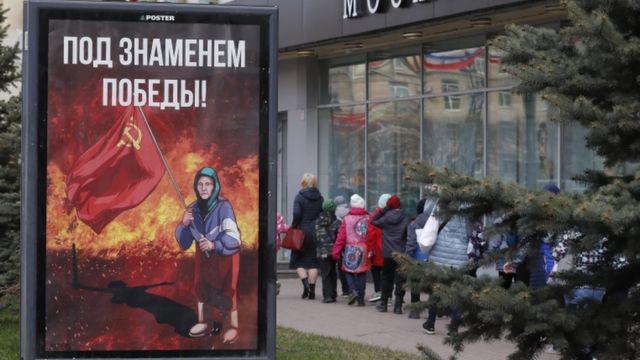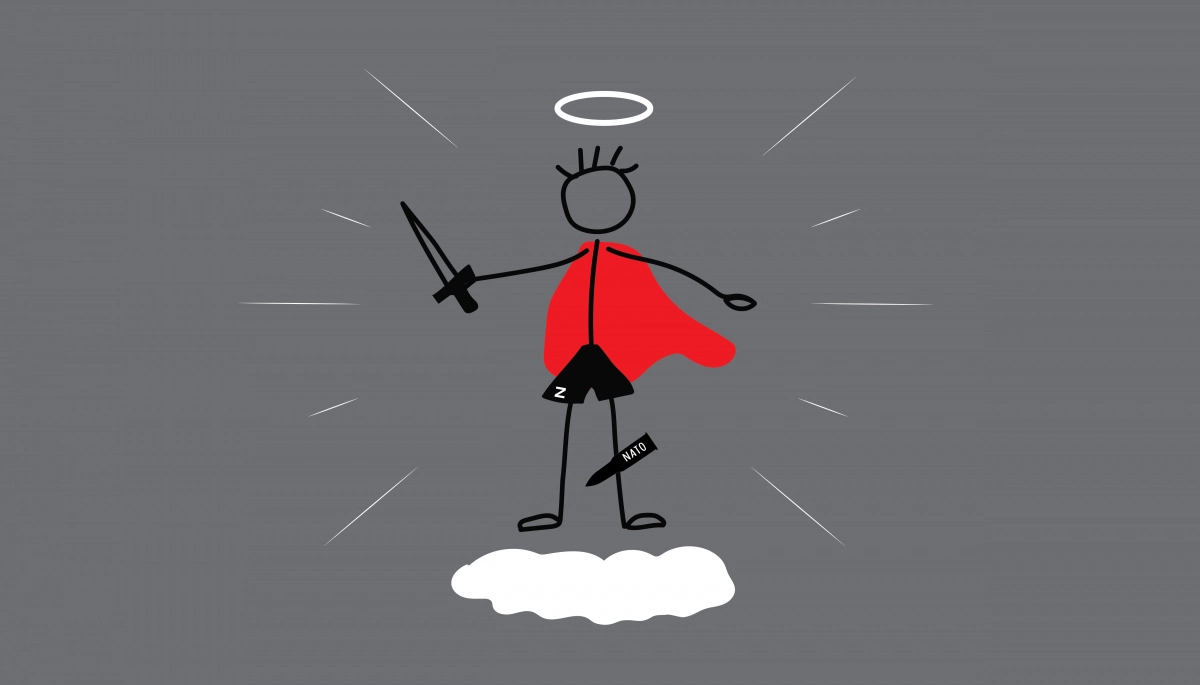Українською читайте тут.
If you believe Russian propaganda (which you shouldn’t), Ukraine spent eight years bombing the Donbas, denying its “self-determination,” imprisoning people for speaking Russian, persecuting Orthodox Christians, committing genocide against pensioners, and desecrating Soviet monuments. For years, Russia cultivated the image of victims who supposedly suffered from the Ukrainian government’s crimes, including the infamous fake story of the “crucified boy in panties”. However, the situation transformed with the onset of the full-scale war, making it challenging to maintain morale based solely on compassion or pity.
Therefore, Russian propaganda resorted to a different tactic: heroization, which entails glorifying someone’s behavior, qualities, and accomplishments. For instance, Russia extols the bravery of the boy Fyodor, who supposedly saved people from violent Ukrainians.
We will delve into how this tactic functions in practice and what Russia aims to achieve with it.
Heroization is a crucial element of wartime propaganda, and, in the case of Russian society, it extends to post-war propaganda as well. For instance, the cult of heroes from the German-Soviet War of 1941-1945, also known as the Great Patriotic War, remains prevalent even today.
In the context of Russia’s full-scale war against Ukraine, heroization serves several crucial purposes. Firstly, it aims to unite the masses around a shared goal of “denazification” and “liberation” of Ukrainian territories. Secondly, it seeks to promote the “right” values and behaviors, including loyalty to the regime, active support for the army, and a willingness to join the war effort. Thirdly, it aims to distract attention from pressing problems by compensating for them with dubious “achievements”. Finally, it aims to justify the aggression against Ukrainians and reinforce the desire for revenge.
Ultimately, heroization creates a romanticized portrayal of death, destruction, and human suffering, which obscures the realities of war and dilutes the human cost of war.
How Russian propaganda swapped the fake "crucified boy" for Fyodor
The boy Fyodor is portrayed in Russian propaganda as a “brave boy from a small village” who purportedly defeated the “Nazis” using his bare hands and saved two girls. According to the propaganda, in early March 2023, “Ukrainian saboteurs” raided the Bryansk region, taking hostages from a local village and opening fire on a school bus, resulting in the injury of a girl who later died in the hospital. This story gained publicity quickly, but it raised more questions than answers due to the lack of evidence and facts. As a result, the propaganda reported that the girl had miraculously survived, only to later reveal that the “girl” was, in fact, an 11-year-old boy named Fyodor.
According to the new version of events, Fyodor and two schoolgirls were purportedly on their way to school, being driven by a fellow villager when “Ukrainian saboteurs” unexpectedly blocked their route. The attackers shot at the car and ordered the children to flee. Fyodor sustained an injury, but he remained unaware of it. The courageous boy responded swiftly, taking the hands of the two girls and leading them to safety. They hitchhiked to school, where teachers discovered that Fyodor had been wounded by a “NATO bullet”.
Russian propaganda quickly seized upon the story, and the boy soon received both popular support, with poems composed in his honor, and state support, including the award of a medal for his valor and bravery. However, the propaganda appeared to embellish the story with excessive special effects, such as hitchhiking to school with a “NATO bullet” lodged in his body and hyperbole. The propaganda machine portrayed the 11-year-old boy as emerging victorious from an attack by heavily armed “saboteurs”.
The tale of Fyodor is reminiscent of the Soviet pioneer heroes and young Red partisan scouts who, depending on the story, engaged in espionage, posted caricatures of the Nazis, gathered weapons and ammunition, and sometimes even killed Nazis. Some of them were even honored with the title of Hero of the USSR. Although the role model is straightforward (a young hero acting in “wartime” conditions), the discrepancies in the facts surrounding Fyodor’s story render it unconvincing, even in comparison to his Soviet predecessors.
The case surrounding Fyodor heavily relies on stirring emotions of empathy and compassion. The boy’s remarkable bravery and selflessness, despite his young age, elicit a strong emotional response from the audience. This sentiment is further heightened by the stark contrast between Fyodor’s valor and the supposed ruthlessness of the “saboteurs”. Additionally, the story instills a sense of unease and danger, as it implies that violent intruders can penetrate Russian borders with impunity.
If we translate these three emotional responses into practical outcomes, they include admiration for Fyodor’s “feat,” fierce hatred toward Ukrainians, and a heightened desire for revenge.
Grandma with a red flag

A poster depicting a Ukrainian grandmother with a red flag and the inscription “Under the Banner of Victory” in St. Petersburg. Photo: epa
At the onset of the full-scale invasion in the spring of 2022, Kremlin media disseminated a video featuring a “grandmother with a Soviet flag”. The propagandists spun a narrative about “Grandma Ania” from the village of Dmytrivka in the Kyiv region, who purportedly welcomed the Russian army with a red flag. When the village came under occupation, her relatives supposedly took her to Russia. The story of “Grandma Ania” was then transformed into posters, murals, newspapers, and even several monuments. One such monument, depicting the old woman with her flag, was erected in Russian Belgorod and occupied Mariupol.
“In Mariupol, on Leninsky Komsomol Square, there is now a monument to grandmother Ania. She was not afraid of the Ukrofascists and defended the Red Flag under which her parents fought. This heroic woman showed the whole world what the memory of our people’s feat during the Great Patriotic War meant to our people. How sacred this memory is to us, and how we are ready to defend it,” wrote propaganda Telegram channels.
Russian propaganda provided a detailed account of how the “liberated from Nazism” grandmother emerged from her home with the Soviet flag that she had been saving for decades for such an occasion. Rather than remaining indifferent and watching events unfold from the safety of her house, she fearlessly stepped out to confront the military with her flag.
Through this story, Russian propaganda reinforces an exemplary behavioral model: if you encounter a Russian soldier, you should welcome them with open arms. The narrative encourages us to share in the “joy of liberation” and empathize with the grandmother. The glorification of her image further reinforces the notion that the “special military operation” (in reality, the Russian war against Ukraine) is a continuation of the German-Soviet war. The propaganda seeks to create the impression that the Russians are on the right track and that ordinary Ukrainians are pleased with “denazification” and in need of even more fervent “liberation”.
Contrary to the agitprop’s narrative, what actually happened was that the house of pensioners Hanna Ivanova and her husband in a village in the Kharkiv region was shelled by the Russian military. Hanna Ivanova nearly lost her life at the hands of the invaders when a Russian shell struck her yard. Ukrainian soldiers helped her evacuate and filmed a video of the old woman running towards them with the flag, as she thought they were Russian soldiers. According to her, the red flag was meant to “appease” the enemy, so they would not destroy the village and Ukraine. The Ukrainian soldiers provided her with food, but she initially tried to refuse it, saying that “you need it more than I do”. One soldier took the Soviet flag from her and trampled on it.
How Wagner PMC Fighters, even those sentenced to life in prison, become heroes
The fighters of the Wagner Private Military Company (PMC) constitute a distinct group in the pantheon of Russian propaganda heroes. In Ukraine, they are regarded as criminals, and in early 2023, the Verkhovna Rada passed a resolution “On Recognizing the Russian Criminal Organization Known as the Wagner Private Military Company or the Wagner Group as an International Criminal Organization and Condemning Its Members” (which we previously covered in greater detail). In Russia, however, they are celebrated as heroes.
A Russian prisoner who was convicted of burning a man alive in 2017 and sentenced to 22 years in prison recently died near Bakhmut. Despite his heinous crime, he was buried with honors in Sevastopol, and during his funeral, the “governor” praised him as a hero. The governor thanked the murderer and commended him for atoning for his crime with his blood.
Another instance of glorifying members of the Wagner PMC is the renaming of a school in Vladivostok after a former mercenary who had fought in both Syria and Ukraine, where he died in the summer of 2022. However, it is worth noting that the son of the deceased does not comprehend why the school was renamed, as his father had never studied there. Furthermore, the documents used for the renaming indicate that the deceased was a Russian hero, but his son denies this information. The school management claimed that the order for renaming came from the city administration.
Wagner’s personnel have been deployed to various conflict zones around the world, including Syria, Sudan, Libya, and the Central African Republic. They have developed a reputation for being extremely ruthless mercenaries who disregard all laws and customs of war. In Ukraine, they are known to carry out heinous acts, such as murder, torture, intimidation, kidnapping, and rape. The United States has designated Wagner as a criminal organization and imposed sanctions on entities affiliated with it. However, in Russia, their crimes are often justified and glorified.
Heroization fosters unrealistic expectations of the military and reinforces a culture of aggression and militarism. On the one hand, it cultivates a culture of “forgiveness” where any wrongdoing is subject to justification and indulgence. New transgressions overshadow the negativity of the past, which Russian propaganda perceives as normal. One can be a murderer or a thief and still be buried with honors or even have a school named after them. On the other hand, this creates a sense of actual impunity for crimes: you can kill or commit other heinous acts, and people will forgive you. Additionally, once you repent and serve the appropriate punishment for murder, the system encourages you to commit new ones. The stigma of past crimes can be washed away by committing new crimes, such as the murder of Ukrainians.
The Cult of Victory
The cult of Victory constitutes a form of Russia’s soft power, which involves fostering a deep obsession with the events of the so-called Great Patriotic War. This is primarily achieved through cultivating a shared memory of the war as an essential attribute of a united Soviet-Russian nation, as well as grandiose celebrations of the anniversaries of historical events.
A significant portion of the history of the USSR is marked by periods of war, including World War II and the Cold War. As a result, the cult of victory was nurtured alongside a culture of militarism. The USSR heavily relied on military force to maintain its power and influence, and official propaganda emphasized the importance of sacrificing the individual for the good of the state. Following the collapse of the Soviet Union, Russian society inherited this cult of militarism.
The further Russia moves away from the victory of 1945, the more extravagant its celebrations become. Upon assuming the presidency, Putin recognized the potential of this concept of victory and effectively incorporated it into the new ideology of the “Russian world”.
Russian propaganda consigns the memory of the war to the militarization of society, ignoring the fact that the victims of World War II were not limited to Russians alone. In fact, Ukrainians constituted a significant portion of the Red Army, ranging from 11 to 33% in different years of the war. Ukraine also accounted for one-third of the USSR’s military (4 out of 12 million) and civilian losses (5 out of 14.5 million) during the war. Despite these facts, Russia claims victory in World War II and attempts to downplay Ukraine’s contributions. One such example of this is the “Immortal Regiment” procession, where Russians carry photos of Soviet soldiers. While this event has been held since 2011, it became much more prominent in 2014 after the start of Russian aggression against Ukraine. The event has since been replicated in other countries around the world, openly funded by the Russian government. With the full-scale invasion, some Russians have started to bring portraits and photographs of Russian soldiers killed during the war against Ukraine, equating the murder of Ukrainians with the fight against Nazism. This is not just an attempt to monopolize the memory of the victory over Nazism but also a disregard for the contributions and sacrifices of other nations.



